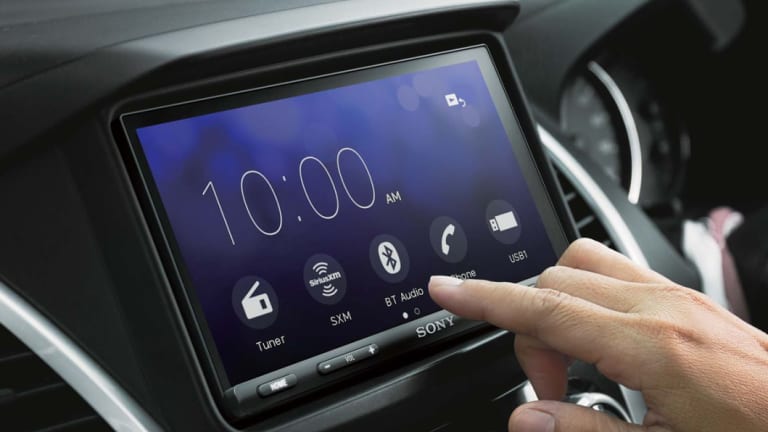My wife puts up with a lot living with me. Our house is a constant testing ground for new technology; every few days I’ll need to explain the speakers now answer to new voice assistant, there’s a new app for turning on the lights, or that nothing works because I broke the internet setting up a router. Rarely is she happy about these changes, and from the thousands of gadgets that have passed through our home in the last few years, I can count on one hand the products she has shown interest in.
Sony’s XAV-AX5000 in car stereo is one of those rare products; after just two days in our dashboard, we both decided we needed to buy it. The unit is Android Auto and Apple CarPlay ready, so when you connect any modern smartphone to it the screen on your device dims, and navigation and a few multimedia apps are served to a large screen in your dashboard. The interface is simplified, with large touch targets that are easy to hit at traffic lights, and voice commands from either Siri or Google Assistant, depending on your phone.
I know nothing about cars and even less about stereo equipment, so finding a suitable unit that supported both Apple CarPlay and Android Auto was daunting. After months of looking at similar unit, I gave up and chose the Sony because it had been chosen the best in class on the New York Times comparison website, The Wirecutter.
Sony’s in-car unit features a big, bright touchscreen.
The XAV-AX5000 retails for $599, and installation was another $300, making it a fairly costly upgrade. Car enthusiasts in my life insist I could’ve installed the unit myself but, again, I know nothing about cars, so wanted to leave it to the experts.
Android Auto and Apple CarPlay have been around a few years, but this was my first time testing either. Both systems are excellent, and leave traditional car dashboard stereos and stand-alone GPS units for dead.
The differences between the Google and Apple’s in-car experience are as you would expect; Android Auto’s main page resembles the cards of Google Assistant — with quick access to your most used apps floating to the top of the screen — and Google Maps always nearby. Apple’s CarPlay home screen looks more like a really large iPhone in landscape mode, and looks a little more polished overall. The system is invite-only for app developers, which means less apps are available, but all the best audio apps are there (Spotify, Pocket Casts, ABC Listen) and iOS 12, released this week, will bring Google Maps and Waze to CarPlay, so you won’t need to rely on Apple Maps.
As an aside, Apple Maps was rightly mocked when it was first released over five years ago, and since that rocky debut many people never gave it a second chance. It’s worth trying again; I find it’s turn by turn navigation to be less visually cluttered than Google Maps and Waze, and it’s live traffic updating and routing (provided by TomTom in Australia) is excellent, and a little less aggressive in trying to find the “optimal route”. Too often Google seems to route me down countless back streets before expecting me to turn against three lanes of traffic, all to save a minute of travel time.
The unit’s location in our dashboard is a little lower than I’d like; the stereo it replaced was never designed to be glanced at as much as the XAV-AX5000. Despite that, the screen is much larger and easier to read than glancing at maps on my phone, and the combination of a giant user interface and voice commands make it an overall safer experience to use while driving.
The bright, massive 17.6cm display immediately switches to the rear-view camera when reversing, which is great for parking and backing out of the driveway. And as CarPlay and Android Auto are powered by our phones, we see this as a one-off investment in the car that should improve over the years as our phones are upgraded.
Source: Read Full Article
